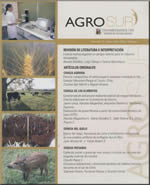Population structure and genetic diversity of bovine meat herds of Southern Chile
Main Article Content
Abstract
The genetic variability observed in domesticated animal species is progressively disappearing due to breed replacement and introgressions aimed at improving productivity and quality. These actions have eroded important adaptation traits, such as disease resistance and tolerance to harsh environments, usually found in local breeds. Currently, there is not sufficient information to understand the relationships among bovine breeds locally adapted and those of exotic origin and recently introduced. In the last decades, a number of genetic markers have become available to study the genetic diversity in a number of domestic animal species. In the present work, 10 microsatellite markers were used to study the genetic diversity and population structure of 212 bovine individuals (eight genotypes) distributed in several geographical Chilean zones. The microsatellites were amplified using PCR and the fragments were separated electrophoretically using the sequencer ABI PRISM 310. The results showed a clear evidence of population structure among eight bovine genotypes found in southern Chile. Estimate the genetic variability through the calculation of gene frequency allowed heterozigosity per locus to be determined, which varied between 0.61 SPS115 to 0.85 TGLA227. The average heterozigosity of the population was 0.73. According to the PIC, all loci studied were informative, with values that ranged from 0.58 SPS115 to 0.84 TGLA227, with an average population of 0.70. It was concluded that among the microsatellite markers analyzed there was a high degree of polymorphism; the number of alleles per locus in the population varied between nine for the SPS115 marker and 19 for the TGLA122 and INRA23 markers, respectively. In this way, the genetic analysis carried out revealed a high hybridization between beef breeds with subsequent probability of 0.99 and an average Fst (Index of genetic differentiation) in the population of 0.1371 (13.7%), which confirm the high genetic variation existing in the populations studied.

